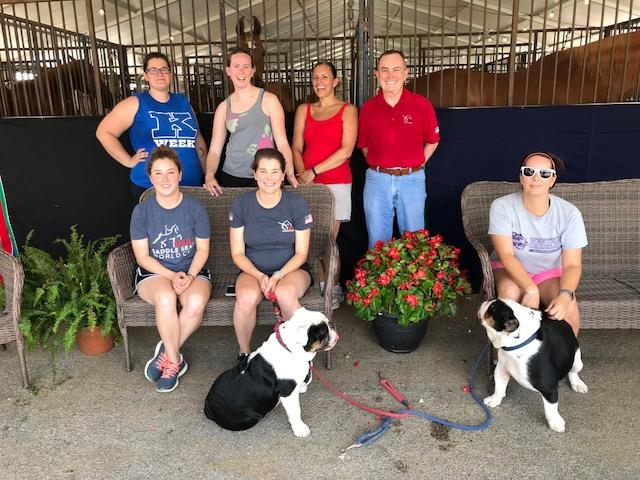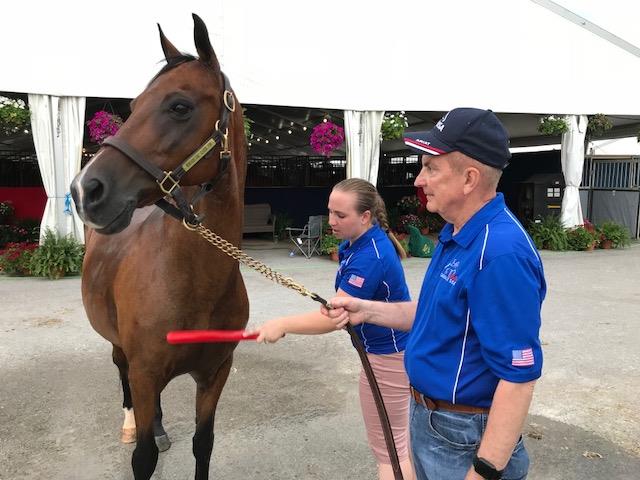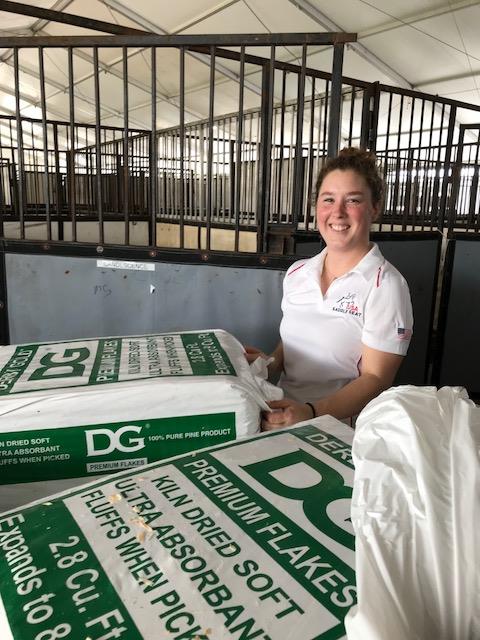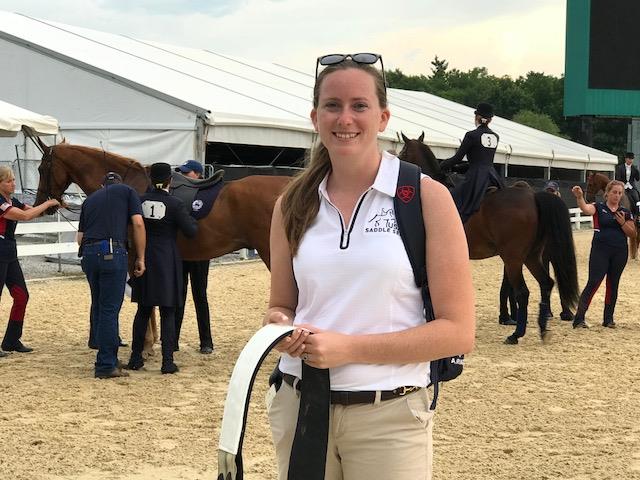When saddle seat teams from Canada, Namibia, South Africa, and the United States converged on Kentucky for the 2018 Saddle Seat World Cup, US Equestrian staff were ready. Hosted this year by US Equestrian, the biennial competition brought 50 horses and 42 team members, coaches, managers, and mentors to the Kentucky Horse Park in Lexington, Ky., July 2-6.

Fortunately, US Equestrian is well stocked with experienced, hands-on equestrians. During the two-day competition and two-day practice, a number of US Equestrian employees—including all eight of the National Affiliates staff—often could be found on the ends of lead shanks, pitchforks, and water hoses alongside some 50 volunteers who took care of both equine and human athletes.
“It really does take a village, and there was so much dedication from everyone who helped us put this on, from the donors, to the US Equestrian staff, to my team in National Affiliates,” said Lori Nelson, Senior Director of National Affiliates. “They worked on the Fourth of July holiday—that’s how dedicated these staff are. One of our volunteers came from US Equestrian’s Customer Care department to work on the holiday. That’s a testament to how dedicated this organization’s staff are to equestrians and horses.”
This small army of staff and volunteers had plenty to do, from hands-on care of the horses to making timed practice sessions and the show itself run like clockwork.

“In order to run this kind of event, we have to feed the horses, water the horses, do the stalls, groom and wash the horses, and check on them at night,” Nelson explained. “Even before the event, we were working closely with the people associated with the horses to get the details of their feed, their tack, and what they needed. Before they got there, we bedded 50 stalls with over 350 bags of shavings and hung all the water buckets.”
On several days, National Affiliates staffers were at the barn at 6:30 a.m. to help care for and get the horses ready. A range of US Equestrian staff and volunteers pitched in to tack and untack horses, run results sheets between judges and score tabulators, hand out water to the riders, and wash the horses in the hot, humid conditions. A typical work day during the event ran 12-16 hours for staff and volunteers.

“We also had to have the right number of people to bring the horses down for the sessions in rotation,” Nelson said. “In the barn, we had a couple of horse trainers who are so committed to this program and who helped manage the barn getting horses out to the ring. It was like an assembly line. There’s so much pride from the staff and volunteers to make the event a quality experience for the team members and spectators and to protect the safety and welfare of the horses and riders in our care. We’re just as committed to these competitions, horses, and riders as our members and competitors are, and we wouldn’t be here if we weren’t. And we are incredibly thankful for the horses. They’re our partners, and we have to do well by them. We wouldn’t be here without them.”
The World Cup’s 52 horses—among them the five-gaited gelding Peppermint Kidd, whom Nelson leases and competes—were all donated for the event by 28 farms and owners who shipped them in from around the country. The group included saddle seat breeds, from the American Saddlebred to a full and half-Arabian to a Morgan. Some came en masse from larger lesson and training barns, like Cascade Stables in Louisiana, which supplied 16 horses and a groom, and Wingswept Farm in Kentucky, which provided six horses and some of their own staff. Pam Roush from Avalon Stables and Krystle Lee from Suncoast Stables brought in horses from Florida and Georgia. Courtney Huguley of Stepping Stone Farm also brought five horses. Others were sent in ones and twos from farms and individual saddle seat supporters, as well as team members who helped round up donors.
“The riders are required to come up with two horses each, whether they are their own horses or two that they arrange to get there,” Nelson noted, adding that at least one team member recruited more than her quota, finding five.

Putting on an event—and especially an international championship like this one—always takes a village, and staff and volunteers’ long experience with horses and shows contributed to making the 2018 Saddle Seat World Cup run smoothly. Some of the staff, like Nelson, are saddle seat competitors themselves, but others hail from eventing, hunter/jumper, and Western disciplines. Through their work at US Equestrian, they’ve gotten to experience a variety of other disciplines and breeds; at the Saddle Seat World Cup, the experience was fully hands-on, Nelson said, noting that the event has taught her staff from other disciplines new skills, like putting on a double bridle. That’s just the kind of community-building that US Equestrian and international events like the 2018 Saddle Seat World Cup are founded on.

Outside the competition, teams and their supporters got to know each other at special evening events organized by US Equestrian’s National Affiliates staff, including a dinner at historic Spindletop Hall, a Lexington Legends baseball game, and a reception at the newly renovated American Saddlebred Museum, which honors one of several US Equestrian-affiliated saddle seat breeds. The international teams also got to take in a fireworks display for a taste of Americans’ Fourth of July celebrations.
This is the kind of equestrian fellowship the founders of the Saddle Seat World Cup envisioned when they established the competition in the early 1980s, Nelson noted.
“They compete against each other, but they also become lifelong friends,” she said of the riders. “So many of these riders compete individually throughout the year, but this is a great opportunity for them to have a team environment. A parent once said to me, ‘We can be at a show and not have anyone from our barn in a class, but there will be one of the World Cup team members in it, and we’ll be cheering for them.’ It becomes a family, and that’s such a positive for our industry.”
Learn more about the Saddle Seat World Cup here, and watch on-demand coverage of the 2018 Saddle Seat World Cup on USEF Network.
Want articles like this delivered to your inbox every week? Sign up to receive the Equestrian Weekly newsletter here.
This article is original content produced by US Equestrian and may only be shared via social media. It is not to be repurposed or used on any other website than USequestrian.org.


